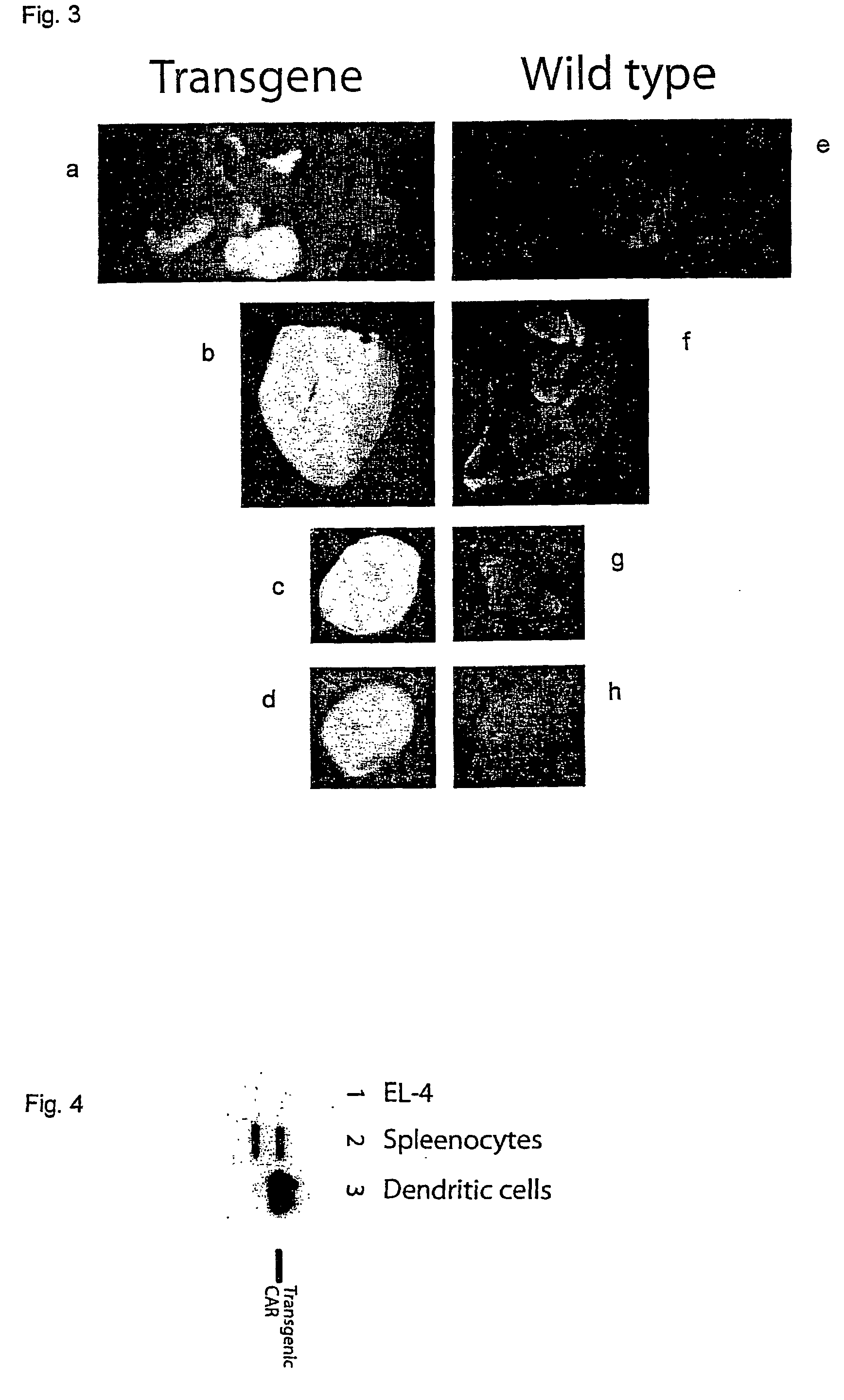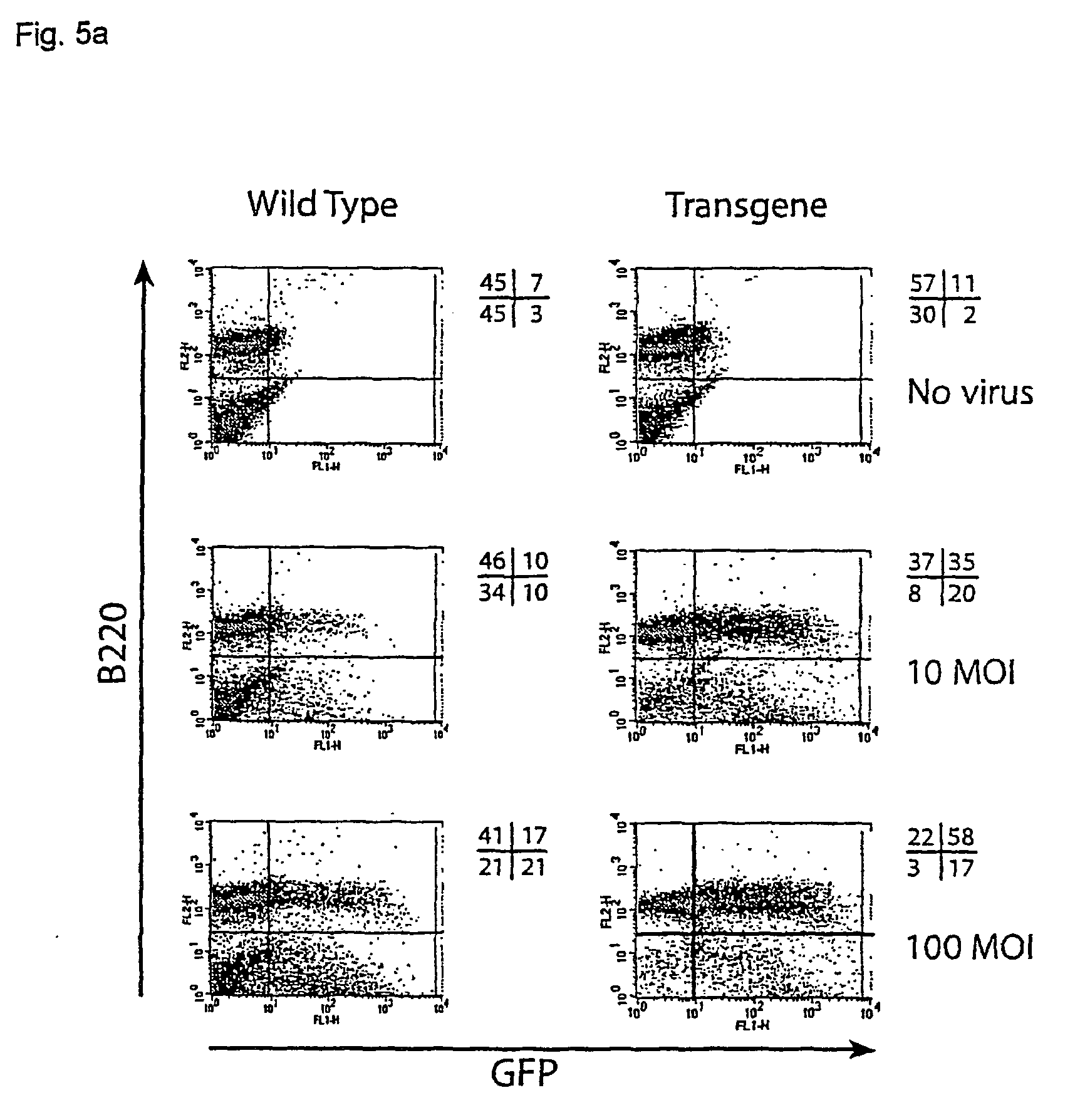Method of obtaining a non-human mammal susceptible to adenovirus-mediated gene delivery, a method for such delivery, and a non-human mammal susceptible to such delivery
- Summary
- Abstract
- Description
- Claims
- Application Information
AI Technical Summary
Benefits of technology
Problems solved by technology
Method used
Image
Examples
example 1
[0036] PCR and Southern blot analyses were made according to standard procedures. The transgene gene construct p.beta.UbiC-hCAR(1-262) containing the human Ubiquitin C promoter (position-1225 to -6, (Schorpp, M. et al., Nucleic Acids Res. 24, 1787-1178 (1996))) was linked to the hCAR receptor (amino acid 1 to 262) gene that lacks its cytoplasmic tail. As previously mentioned, the latter is not required for efficient Ad infections. p.beta.UbiC-hCAR(1-262) contains a rabbit .beta.-globin splice / polyadenylation signal from the pSCT expression vector. The transgene was cut with Xho I and Sph I, purified and injected into fertilised oocytes as described previously by Arulampalam, V., Grant, P. A., Samuelsson, A., Lendahl, U. and Pettersson, in S., Eur. J. Immunol. 24, 1671-1677 (1994).
[0037] Mice carrying the truncated hCAR were initially screened by PCR and several independent transgenic founders were identified. Male founders were used to derive seven independent transgenic lines. The ...
example 2
[0040] To assess whether the transgenic hCAR mice displayed increased susceptibility to Ad-mediated gene delivery, 10.sup.8 cpe units of a recombinant Ad expressing the green fluorescent protein AdGFP was injected in the peritoneal cavity of a transgenic mouse (a, b, c and d) and a negative littermate (e, f, g and h). After 24 hours, the GFP expression levels in the peritoneal cavities were monitored with a fluorescence image analyser system as depicted in FIG. 3a and 3e. A considerably enhanced susceptibility towards Ad-mediated gene delivery of the transgenic mouse was observed as compared to the negative littermate. Furthermore, whole organs were assessed for GFP expression; the transgenic liver shown in FIG. 3b, the transgenic omentum containing fat tissue shown in FIG. 2c, and the transgenic urinary bladder shown in FIG. 2d, were much more fluorescent than corresponding organs of the control mouse, shown in FIG. 3f, g and h, respectively. Thus, the broad expression of the trans...
example 3
[0041] Primary B lymphocytes are generally known to be very resistant to most currently available gene transfer techniques, including adenoviral vectors. These primary cells therefore provide an instructive medium in which to assess the extent that the hCAR transgene increases Ad virus gene delivery.
[0042] The presence of the hCAR protein in the spleenocytes of transgenic animals was examined by Western blot, shown in FIG. 4. Expression levels of the hCAR transgene in spleenocytes and DCs was confirmed by Western blot with the RmcB antibody. In FIG. 4, lane 1 is negative control: the CAR deficient EL-4 mouse thymoma cell line, lane 2 is spleenocytes and Lane 3 is dendritic cells.
[0043] Single cell suspensions of spleenocytes obtained from a trangenic mouse and a negative littermate were stimulated with PMA and infected with different quantities of AdGFP (MOI 0, 10 or 100). After 36 hours, the live cells were analysed for the expression of GFP and for the presence the lymphocyte mark...
PUM
 Login to View More
Login to View More Abstract
Description
Claims
Application Information
 Login to View More
Login to View More - R&D
- Intellectual Property
- Life Sciences
- Materials
- Tech Scout
- Unparalleled Data Quality
- Higher Quality Content
- 60% Fewer Hallucinations
Browse by: Latest US Patents, China's latest patents, Technical Efficacy Thesaurus, Application Domain, Technology Topic, Popular Technical Reports.
© 2025 PatSnap. All rights reserved.Legal|Privacy policy|Modern Slavery Act Transparency Statement|Sitemap|About US| Contact US: help@patsnap.com



